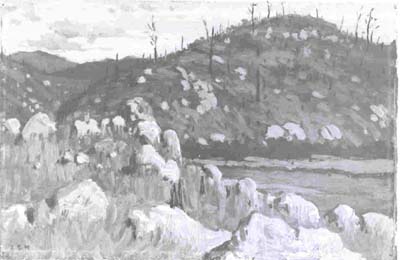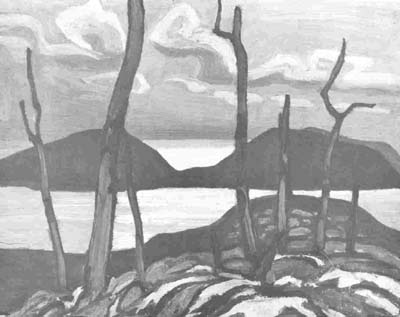
Bulletin 23, 1974
Home
Français
Introduction
History
Annual Index
Author &
Subject
Credits
Contact


A Portfolio of Landscapes by Lawren S. Harris
by Peter Larisey
Article en français
Page 1
For more than two decades, from 1908 to 1930, painting the Canadian landscape was Lawren
S. Harris's main concern. These eight works, which together span his
landscape period, were chosen for this portfolio because they are not generally
known.
Near St-Jovite (fig. I) was probably painted on Harris's
first northern sketching trip - to the Laurentians in 1908 - and so demonstrates
the level of accomplishment, in painting with oils, that he brought with
hill from Germany. It is also the earliest expression we have found so
far of Harris's vision of Canada's empty and remote North. The colours,
as in other early works I've seen - one watercolour and several small oils - are locked within a brown tonal colour system.
In Near St-Jovite it is mainly the darker values of brown which are heavily applied and worked.
The decaying old house pictured in Sketch (Abandoned House) (fig.
2) is as close as Harris ever comes to the Canadian Art Club's notion
of the picturesque.
The Pine Tree, done c. 1918 (fig. 3), is typical
of Harris's rarely-seen Lake Simcoe sketches. All of them, like Harris's
contemporary paintings of houses, have a low, frontal point of view of a
Hat lake-country landscape, and stress the low horizon line and the wide,
high sky. In contrast to the brilliant autumn colours one associates with
the Croup of Seven, the Lake Simcoe works are painted in the blues and
greens of summer. In a letter of 1918, Harris referred to them without
enthusiasm as being mainly "sky studies." Nevertheless, The Pine Tree,
painted less than a decade after the static Near St-Jovite, shows Harris's growing mastery of various painterly techniques, summarized
in this painting by the convincing integration of composition and brushwork,
used to depict both near and distant objects in a coherent and lively pictorial space.
Harris's most important landscape period (which would last for twelve years), began
with his first trips to the Algoma Region of Northern Ontario in 1918.
The change in his painting accompanied a refound enthusiasm for the North.
These two Algoma works (figs 4 & 5) are samples drawn from among the
many painting techniques that Harris developed in presenting the great
variety of motifs he found in Algoma, on the eight sketching trips he made
there between 1918 and 1924. In many of the early Algoma paintings, the
viewer must confront a solid wall of wilderness which completely fills
the surface of the painting in a very shallow spatial composition. Wood
Interior, Algoma (fig. 4), done c. 1919, is a metaphorical image of the movement across such shallow space,
through the wall, into the deeper spaces that Harris was at this time beginning
to find more important.
The wide and deep grasp of space presented in Algoma
Sketch (LXVI1l) (fig. 5) extends this interest. There is a robust contrast
between the deep blue of the lake and the yellow-orange of the foliage.
The brushstrokes summarize not only the shapes of nearby trees, but also
the large surfaces of the distant hills.
Many of the visual themes of Harris's North Shore Lake Superior paintings
occur in North Shore, Lake Superior, Pic Island (fig. 6). The austere
landscape forms, the screen of dead trees through which one sees a low
hill and the lake, Pic Island itself, and the strong cloud formations - all
are brought together in a rich and subtle brown tonal painting.
Kinney's Lake, Mount Robson (fig, 7) is only one of the many
sketches Harris painted of the Mount Robson area in the Canadian Rocky Mountains. Harris achieved a sense of a remote and monumental silence mainly
by the careful composition of summary forms and smooth surfaces, although
the image of reflection in still water played an important role.
We have become familiar with those Arctic sketches and paintings which Harris
did of the impressive mountainous landscapes of Bylot Island, during the
second half of his Arctic trip of 1930. Fog and Ice, Kane Basin (fig.
8) was sketched during the earlier part of the trip when he was farthest
north. Harris has constructed a carefully balanced, spatially deep image,
using only blues, greys, and whites, and minimal landscape elements - water,
ice, and cloud and fog formations.
Annual Index | Author & Subject | Credits | Contact
This digital collection
was produced under contract to Canada's Digital Collections program,
Industry Canada.
"Digital
Collections Program, Copyright
© National Gallery of
Canada 2001"